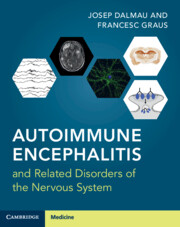Book contents
- Autoimmune Encephalitis and Related Disorders of the Nervous System
- Autoimmune Encephalitis and Related Disorders of the Nervous System
- Copyright page
- Dedication
- Contents
- Clinical Vignettes
- Videos
- Preface
- Abbreviations
- Section 1 Overview
- Section 2 Antibodies and Antigens
- Section 3 Specific Syndromes and Diseases
- Chapter 6 Limbic Encephalitis
- Chapter 7 Autoimmunity Against Proteins Associated with Voltage-Gated Potassium Channels
- Chapter 8 Anti-NMDAR Encephalitis
- Chapter 9 Seizures and Antibodies Against Surface Antigens
- Chapter 10 Acute Disseminated Encephalomyelitis and Myelin Oligodendrocyte Glycoprotein Antibody-Associated Disease
- Chapter 11 Neuromyelitis Optica Spectrum Disorders and Glial Fibrillary Acidic Protein Autoimmunity
- Chapter 12 Autoimmune Cerebellar Ataxias
- Chapter 13 Autoimmune Brainstem Encephalitis
- Chapter 14 Autoimmunity Against the Inhibitory Synapsis
- Chapter 15 Anti-IgLON5 Disease
- Chapter 16 Autoimmune and Inflammatory Encephalopathies as Complications of Cancer
- Chapter 17 Deconstructing Hashimoto Encephalopathy
- Chapter 18 CNS Syndromes at the Frontier of Autoimmune Encephalitis
- Section 4 Autoimmunity in Neurological and Psychiatric Diseases
- Index
- References
Chapter 9 - Seizures and Antibodies Against Surface Antigens
from Section 3 - Specific Syndromes and Diseases
Published online by Cambridge University Press: 27 January 2022
- Autoimmune Encephalitis and Related Disorders of the Nervous System
- Autoimmune Encephalitis and Related Disorders of the Nervous System
- Copyright page
- Dedication
- Contents
- Clinical Vignettes
- Videos
- Preface
- Abbreviations
- Section 1 Overview
- Section 2 Antibodies and Antigens
- Section 3 Specific Syndromes and Diseases
- Chapter 6 Limbic Encephalitis
- Chapter 7 Autoimmunity Against Proteins Associated with Voltage-Gated Potassium Channels
- Chapter 8 Anti-NMDAR Encephalitis
- Chapter 9 Seizures and Antibodies Against Surface Antigens
- Chapter 10 Acute Disseminated Encephalomyelitis and Myelin Oligodendrocyte Glycoprotein Antibody-Associated Disease
- Chapter 11 Neuromyelitis Optica Spectrum Disorders and Glial Fibrillary Acidic Protein Autoimmunity
- Chapter 12 Autoimmune Cerebellar Ataxias
- Chapter 13 Autoimmune Brainstem Encephalitis
- Chapter 14 Autoimmunity Against the Inhibitory Synapsis
- Chapter 15 Anti-IgLON5 Disease
- Chapter 16 Autoimmune and Inflammatory Encephalopathies as Complications of Cancer
- Chapter 17 Deconstructing Hashimoto Encephalopathy
- Chapter 18 CNS Syndromes at the Frontier of Autoimmune Encephalitis
- Section 4 Autoimmunity in Neurological and Psychiatric Diseases
- Index
- References
Summary
Seizures are common in all types of autoimmune encephalitis, but their frequency and severity are particularly relevant in anti-NMDAR, anti-GABAbR, anti-GABAaR, and anti-LGI encephalitis. Seizures occur in>70% of patients in the acute phase of anti-NMDAR encephalitis without specific or distinctive features that may suggest this disorder. In anti-GABAbR and particularly anti-LGI1 encephalitis, seizures may precede in weeks the development of cognitive and psychiatric symptoms. Faciobrachial dystonic seizures (FBDS) are very typical of anti-LGI1 encephalitis and their recognition is important to make an early diagnosis. New-onset refractory status epilepticus (NORSE) is a clinical presentation of epilepsy that occurs in patients without previous history of seizures. When NORSE is preceded by a febrile episode, the term FIRES (febrile infection-related epilepsy syndrome) is frequently used, particularly in the paediatric literature. FIRES is considered a subtype of NORSE that may occur at any age. Only a small number of patients with anti-NMDAR or anti-GABAbR encephalitis presents as NORSE. The term FLAMES (FLAIR-hyperintense Lesions in anti-MOG associated encephalitis with seizures) has been used to describe the encephalitis of some patients with MOG antibodies. The clinical presentation includes seizures associated with isolated or predominantly unilateral cortical hyperintense lesions in FLAIR MRI images.
Keywords
- Type
- Chapter
- Information
- Publisher: Cambridge University PressPrint publication year: 2022

